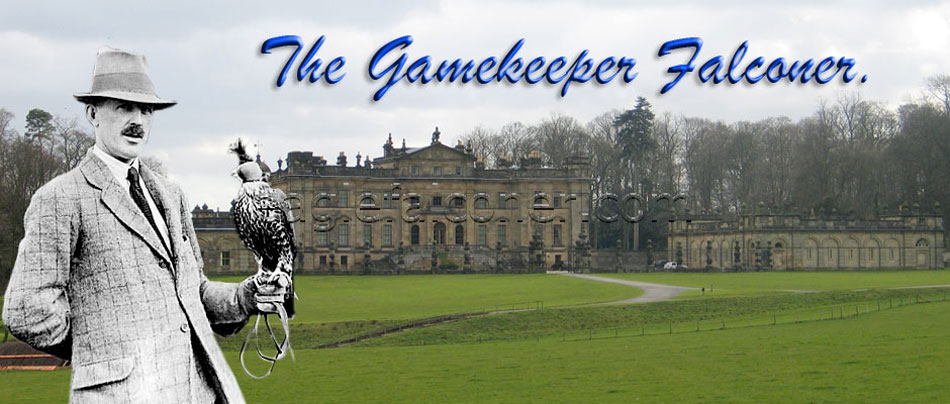'THE GAMEKEEPER FALCONER.'
by
Alan Gates.
Extracted from
'ADAM GORDON, A COUNTRYMAN'S COUNTRYMAN'
by the same author.
First Published in The Falconers & Raptor Conservation Magazine Winter 1992 Issue 13
I moved to live in North Yorkshire in April 1972, and my first priority was to contact any fellow falconers who may be living in the near vicinity. Luckily, such a fellow lived in the nearest town of Pickering. Bill Mitton was a representative for an agricultural seed merchants and in his spare time was an austringer and aviculturist. His main passion was his female goshawk, 'Kea', and through his job he was able to procure ample farming land to fly his hawk over.
It was through Bill's generous hospitality that I was invited one evening to visit a retired gamekeeper who practised taxidermy and at one time had been a falconer. I remember being less than enthusiastic at the time, gamekeepers and birds of prey seemed to be at the opposite ends of the scheme of things. Although being at a loose end that evening I went along for the ride.
Duncombe Park and the huge Helmsley estate of the Fevershams' was our destination, as we drove up the concrete road (which was laid by the Armed forces during the First War) one could not help but be impressed by the stately home of Thomas Duncombe. We turned off the drive in front of the main house towards a Yorkshire stone building which had possibly been built as a kennels, to house a pack of foxhounds perhaps. I was told that at the turn of the century this building had been a laundry, but since his return from the First War, our host now retired Head Keeper Adam Gordon had lived here. A tall straight backed gentleman met us at the gate to his cottage and he was introduced to me as 'Gordon', although in his mid eighties he belied the look of a sprightly sixty-year old. We were cordially greeted and ushered into the outbuilding that had been the kennels/laundry, and was now Gordon's taxidermy workshop. There were a number of finished specimens assembled on a bench, crows, owls, stoats, weasels etc., all unfortunate road casualty victims. Bill was presented with a fine specimen of a stoat with dark beady eyes, it still breathed the illusion of life that final accolade of the taxidermists art. I marvelled at a cock yellowhammer perched on a sprig of gorse, not so much at the quality of workmanship, which was outstanding, but more at the large strong hands and slightly fading eyesight which had performed this work of art. The hospitality extended to supper in the cottage were I met Gordon's wife Minnie, a small silver haired homely woman with a round friendly face. As I sat in the dimly lit sitting room, a dark framed print of a hooded peregrine hung on the wall. Closer examination revealed that it was a photogravure print of a painting by Sonderland of 'Sultan', 3 years old, the property of Mr.E.C.Newcombe. Loo 1843. An inscription read as follows; 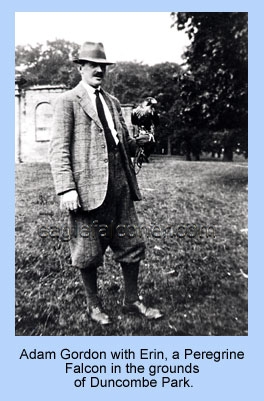 'To the members of The Old Hawking Club this plate is inscribed by their devoted Colleague: Pierre Amédée Pichot. 'Sultan' and 'De Ruyter' were a very famous cast of heron falcons. They originally belonged to the Loo Hawking Club of Holland, of which Edward Clough Newcome was a founder member. They came into his ownership around 1843 and in that year and the following year took over one hundred herons. These falcons were flown at rooks as a warm up before the heron season started, unfortunately 'De Ruyter' was lost after a rook at Fetwell. Monsieur Pierre Pichot organised a new club in France called The Champagne Hawking Club in 1866. The headquarters were at Châlons. In 1870 when war broke out between France and Germany the club hawks were sent to Dhuleep Singh at Elveden Hall at Thetford. Earlier in 1863 the Hon.Cecil Duncombe (the first Earl of Feversham's younger brother) and Major Charles Hawkins Fisher started spring rook hawking on Salisbury plain. They made their headquarters the Bustard Inn, beside the old direct road from Devizes to Salisbury. Robert Barr was employed as falconer and they had a first rate team of six or seven passage falcons from Valkenswaard in Holland. 'To the members of The Old Hawking Club this plate is inscribed by their devoted Colleague: Pierre Amédée Pichot. 'Sultan' and 'De Ruyter' were a very famous cast of heron falcons. They originally belonged to the Loo Hawking Club of Holland, of which Edward Clough Newcome was a founder member. They came into his ownership around 1843 and in that year and the following year took over one hundred herons. These falcons were flown at rooks as a warm up before the heron season started, unfortunately 'De Ruyter' was lost after a rook at Fetwell. Monsieur Pierre Pichot organised a new club in France called The Champagne Hawking Club in 1866. The headquarters were at Châlons. In 1870 when war broke out between France and Germany the club hawks were sent to Dhuleep Singh at Elveden Hall at Thetford. Earlier in 1863 the Hon.Cecil Duncombe (the first Earl of Feversham's younger brother) and Major Charles Hawkins Fisher started spring rook hawking on Salisbury plain. They made their headquarters the Bustard Inn, beside the old direct road from Devizes to Salisbury. Robert Barr was employed as falconer and they had a first rate team of six or seven passage falcons from Valkenswaard in Holland.
The following year a small club was formed that blossomed into the Old Hawking Club. Robert Barr continued as falconer and the manager was that old famous falconer, Edward Clough Newcome. In its first year the club membership stood at seven, the Hon. Cecil Duncombe, Lord Lilford, the Maharajah Dhuleep Singh, Mr.Amherst, Col.Brooksbank, A.E.Knox and Newcome.
Newcome died in 1871, the club was at a low ebb, and a meeting in late Autumn of the year between Cecil Duncombe, A.E.Knox and Gerald Lascelles at Gordon Castle agreed to reorganise the Old Hawking Club on a more substantial basis. They were successful as the Club lasted for sixty two years. Throughout that time Cecil Duncombe was a mainstay and saw the rise of friend Gerald Lascelles and his son-in-law Herbert St.Quintin both exceedingly good falconers.
The print had belonged to the First Earl of Feversham,(Cecils' older brother) who had been a subscriber to the Old Hawking Club. On his death the mansion in Duncombe Park passed into institutional occupation as a girls' school, were upon all the Earls' belongings were removed and the print was given to Gordon. On the sideboard was a 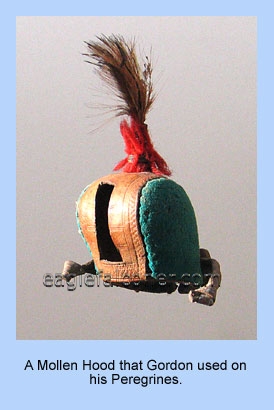 mounted peregrine, hooded,belled and jessed , sitting on a block. This was one of Gordon's' favourite tiercels and an exceptional partridge hawk. Sadly it had stooped through a bunch of pole mounted telegraph wires and was killed by the collision. These wires were a particular hazard to all birds, they often had corks threaded on them in an attempt to make them more visible to flying birds. mounted peregrine, hooded,belled and jessed , sitting on a block. This was one of Gordon's' favourite tiercels and an exceptional partridge hawk. Sadly it had stooped through a bunch of pole mounted telegraph wires and was killed by the collision. These wires were a particular hazard to all birds, they often had corks threaded on them in an attempt to make them more visible to flying birds.
Gordon joined me at the table, in his hands was an old biscuit tin, the contents were numerous photographs of hawks, falcons and people, together with a few bits of falconry furniture. This biscuit tin was to be the centre of many long and happy hours spent in the company of Adam Gordon.
Gordon was born on March 25th. 1885 of Scottish parents, the eldest of two boys. His father James was a keeper working in Ireland. He left home at the age of fourteen, to work as an apprentice taxidermist for Mr.Williams of Dame Street, Dublin. After two years of City life the call of the country became too strong, and a chance meeting with Mr.Gilbert with the offer of employment as apprentice falconer was just the sort of diversity that the young Gordon enjoyed. Mr.Gilbert rode around England and Ireland with his falcons, although initially when Gordon joined him he was flying a team of peregrines at rook on the Curragh.
Who precisely Mr. Gilbert the falconer was I was never able to determine, however, he gave Gordon a sound grounding in the art of falconry. The year was 1906 and they shared the Curragh with fine company, at the same time Gilbert Blaine and his fine team of peregrines were flying the rooks. Although in Blaine's opinion, the Curragh was too cramped for anything but a double flight. There were, besides, plenty of obstacles in the shape of carts, small parties of cavalry, racing strings, etc., which gave rooks opportunities for foiling the hawks.
This is pure speculation, but I am in no doubt that Mr.Gilbert and Gordon met up with Blaine and his team and on occasions hawked together. In fact is it not just possible that Gordon's Mr.Gilbert was Gilbert Blaine?. Gordon followed Mr.Gilbert and his falcons for two years before moving to work for the Duke of Portland at Welbeck. This was a large and extensive estate employing over thirty keepers under the guiding eye of Mr.Weir the head keeper.
Gordon moved onto Windsor in 1909 as assistant keeper on a beat of the pheasant shoot for King Edward VII.
In 1912 Gordon answered an advertisement from Lord Helmsley for a man who could train falcons and gun dogs. He met Lord Helmsley at Nawton Towers and was taken by him for a short walk through the woods to see what he knew. They had only been walking for a few minutes when Gordon asked Lord Helmsley to make his dog sit and to walk back with him ten yards. Gordon pointed out a woodcock a few feet from the path, sitting on its nest and so well camouflaged as to be almost invisible. Gordon was given the job on the spot. Lord Helmsley had a sound knowledge of falconry gleaned from his time in the Sudan. Falconry had been passionately pursued by his predecessors, most notably Cecil Duncombe who was the 1st.Earl's younger brother. The 1st.Earl, Lord Helmsley's grandfather affectionally known as the 'old Earl' had been a Subscriber of The Old Hawking Club for many years, although never actually being a falconer he had a strong association.
The 'Old Earl' lived in the large house in Duncombe Park and Gordon recalls only meeting him once, when he was 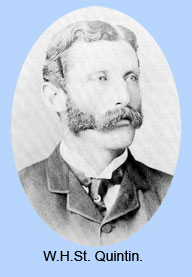 requested to bring the goshawk for the Earl to see. Peregrines were obtained from Ireland and Scotland as eyasses, the Scottish falcons came from the Duke of Portlands, Langwell Estate at Berriedale. These falcons were hacked at Nawton Towers and were trained as game hawks, flying at grouse, pheasant and partridge. Grouse hawking was mainly on Roper moor above Helmsley, but a huge area was available for hawking pheasant and partridge on estate farm land from Nawton Towers to Harome. requested to bring the goshawk for the Earl to see. Peregrines were obtained from Ireland and Scotland as eyasses, the Scottish falcons came from the Duke of Portlands, Langwell Estate at Berriedale. These falcons were hacked at Nawton Towers and were trained as game hawks, flying at grouse, pheasant and partridge. Grouse hawking was mainly on Roper moor above Helmsley, but a huge area was available for hawking pheasant and partridge on estate farm land from Nawton Towers to Harome.
Gordon would discourage his young falcons from flying pigeons by buying barn pigeons from the farmers at sixpence a time, and releasing them when the falcon was waiting on a little down wind. This would give the advantage to the pigeon, after a long chase the falcon would give up and return, only to have another pigeon released. Soon the falcon learned that chasing pigeon was unrewarding. The farmers were happy as most of the pigeons returned and could be sold again when Gordon needed them.
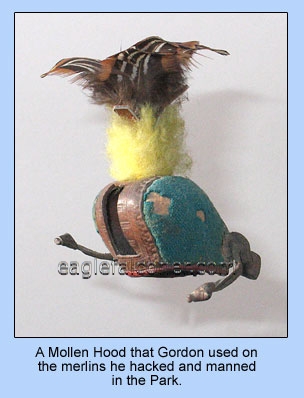 Mr. St.Quintin of Scampston Hall, who in his younger days had been one of the most active members of the Old Hawking Club, gave Lord Helmsley and Gordon most of his falconry furniture. Mr. St.Quintin of Scampston Hall, who in his younger days had been one of the most active members of the Old Hawking Club, gave Lord Helmsley and Gordon most of his falconry furniture.
Gordon obtained a passage Goshawk from Karl Mollen of Valkenswaard and together with Lord Helmsley enjoyed some fine sport at the many rabbit warrens on the estate. This was the only hawk Gordon ever lost outright. It was at the insistence of Lord Helmsley that they try a flight or two at rabbits one windy afternoon. They visited the warren just above Nawton Towers, by the water filter beds. As Gordon stood on the hill the gos left the fist in pursuit of a rabbit in the field below. With the advantage of height it flew like a bullet and killed a rabbit, unfortunately the field contained young cattle which circled round the hawk. Startled by the commotion of the cattle the hawk left the rabbit and lifted into the air, whereupon the wind caught it and blew it down the dale. Gordon heard that it had killed a chicken in a farmyard a few days later, but was unable to locate it. A few weeks later the First World War broke out.
All the falcons and hawks were sold when war broke out, and Lord Helmsley formed the Yorkshire Hussars mainly from volunteers. Gordon volunteered and underwent two months training before being sent into action in France.
Being a crack rifle Shot, he was made sniper and often was left alone in 'no man's land' to pick off unwary Germans. His bravery was renowned; he was wounded twice and was awarded the MM and DCM and bar.
Sadly the war claimed the life of Lord Helmsley, he was killed in action on the Somme. September 15th. 1916 was reported as one of the quietest days, the single round from a snipers rifle being the only shot fired.
After the war Gordon returned to Nawton Towers under the stewardship of Colonel Duncombe. Charles William, Lord Helmsley's eldest son and now the third Earl, was only twelve years old. Gordon was made head Keeper and had ten keepers under him and several shoots to supervise, again he kept falcons and goshawks, a notable amongst these was Erin an eyas falcon from Ireland.
Gordon moved from Nawton Towers to reside in the grounds of the main house in Duncombe Park, since the loss of both the first and second Earl the house was passed into institutional occupation as a girls school. As the third Earl grew up he took an interest in falconry under the guidance of Gordon, and it was by chance that in the early twenties the now late Capt.C.W.R.Knight, wildlife film maker, naturalist and falconer visited the school to present a film and give a lecturer. Capt.Knight returned to the school in the coming years to show films and fly his famous golden eagle, Mr. Ramshaw.
A natural friendship developed, and Knight would partake of the hospitality offered by his Lordship at Nawton Towers. Mr.Ramshaw would likewise be thankful for a shady corner for his block in Gordon's walled garden. Capt.Knight particularly enjoyed flying merlins at lark and an arrangement developed which was to continue for 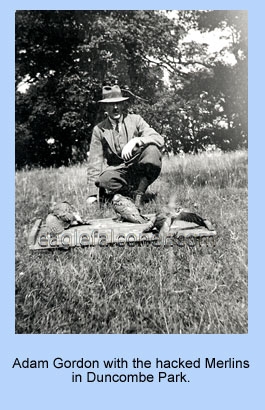 many years. Gordon knew of merlins nesting on the estates moorland and collected the eyasses each season. They were hacked in the Park in the trees near Gordon's house, as soon as they showed signs of independence they were caught with a bow-net. They were collected together and transported in a padded hamper by train to Sevenoaks. many years. Gordon knew of merlins nesting on the estates moorland and collected the eyasses each season. They were hacked in the Park in the trees near Gordon's house, as soon as they showed signs of independence they were caught with a bow-net. They were collected together and transported in a padded hamper by train to Sevenoaks.
Capt.Knight and his brother Hugh together with a collection of friends would all assemble at Avebury, on Salisbury Plain every season to fly the merlins at lark. At the seasons end the merlins were returned to Gordon in Yorkshire to be released on the same moorland. This was of great benefit to the local merlin population as it insured many more fledgeling merlins reached maturity. Knight had a great respect for Gordon and returned the hospitality by an invitation for Gordon and his wife and daughter, to his London film premiere of William and William's sister. A culmination of an expedition to the Grampian highlands to film the homelife of a pair of Golden eagles and their two eaglets.
Although Gordon's principle occupation was keepering the estate he still maintained a number of trained falcons and hawks. In 1928 the Third Earl joined the fledgeling British Falconers Club, he was nominated by Capt.Charles Knight. The Earl continued his membership until the Second War. After the Second War, with the estate returned to normality Gordon virtually created the Beckdale and Riccaldale beats, and along with Ashdale the shoot was let to a local syndicate. It all started as a fairly modest affair with 3000-4000 pheasants reared. In 1956 Lord Feversham saw the potential of combining the three valleys and he asked Gordon to plan out its future. Duncombe Park was developed later as a shoot and some would say in quality was the best of the lot. Gordon planned and ran the Helmsley shoot for ten years until his retirement. It has been regarded by many as one of the best pheasant shoots in Britain, and Adam Gordon as one of the most remarkable Head keepers.
|
